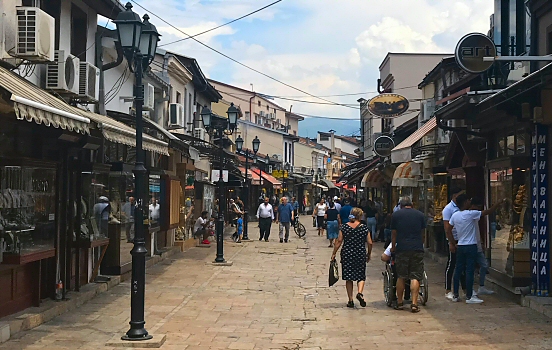There’s a strange wind that blows through the Balkans. Not the kind that rustles leaves and cools your neck in the heat. This one carries the weight of empires, the smoke of old battles and the stubborn dreams of people who refuse to vanish.
As I crossed the border from Albania to Macedonia, I kept a careful eye on the signs. The republic of Macedonia is the country I’m aiming for, but there is also a region of adjacent Greece which claims the name Macedonia. To make things more complicated, the republic has opted to change its name to North Macedonia.
Macedonia was once an ancient kingdom of great importance. During the reign of Alexander the Great 2300 years ago, his empire was the most powerful in the world, ranging all the way to the Indus river. In 168 BC the Macedonian monarchs were replaced by Roman rulers. Later decades saw the rise of Ottoman dominion as well as the formation of Yugoslavia.
 The giant Alexander the Great statue in Skopje.
The giant Alexander the Great statue in Skopje.
Skopje seems like a city with an identity crisis and a fierce desire to be seen. It’s been rebuilt so many times, it’s hard to tell where the facade ends and the story starts. The 1963 earthquake flattened much of the place, and what rose from the rubble is a Frankenstein’s monster of brutalist concrete, faux-neoclassical grandeur and an over-the-top nationalism that would make Tito blush.
There are statues. Big ones. Of warriors, saints, revolutionaries and even a few who look suspiciously like they wandered in from a video game. The government dumped millions into these monuments during the controversial “Skopje 2014” project, and the result is somewhere between Disneyland and a Balkan version of the typewriter monument in Rome.
 Old Bazaar quarters.
Old Bazaar quarters.
I stand below the statue of Alexander at Plostad Makedonija, the central square of Skopje, trying to envision what this place looked like decades ago. But any such things cannot longer be found in this district, so I walk north across the bridge into the Old Bazaar quarters. The proud heritage can still be seen in the Ottoman architectural style, hiding below the large stone fortress. The air hums with ambition, nostalgia and just a hint of melancholy.
Skopje is a place trying to find itself. A place that wears its scars on the outside, like medals or warnings.

Comments
No comments yet.
Leave a reply